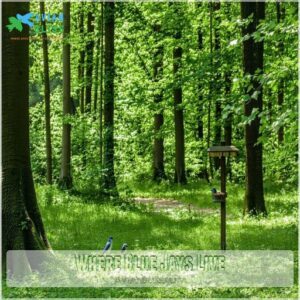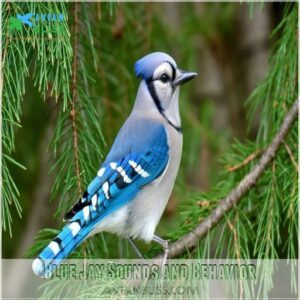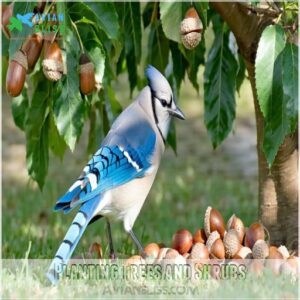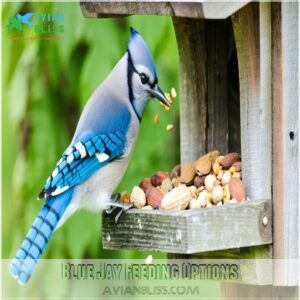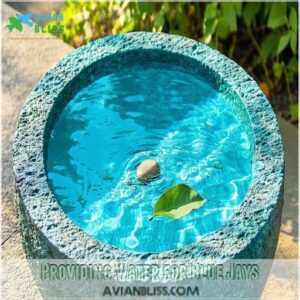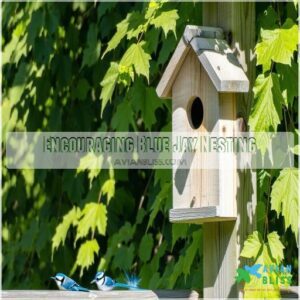This site is supported by our readers. We may earn a commission, at no cost to you, if you purchase through links.

Blue jays love a good splash too, so set up a shallow birdbath. They’re also fans of berry and nut-bearing trees like oak and dogwood.
Skip the pesticides; these birds enjoy a chemical-free zone. Keep your cat indoors to make sure a drama-free dining experience.
With a touch of bird culinary magic, your yard will soon be the go-to spot for jays. And there’s more you can do!
Table Of Contents
- Key Takeaways
- Blue Jay Habitat and Appearance
- Attract Blue Jays to Your Yard
- Blue Jay Diet and Feeding Behavior
- Blue Jay Sounds and Behavior
- Creating a Blue Jay Friendly Yard
- Blue Jay Feeding Options
- Providing Water for Blue Jays
- Encouraging Blue Jay Nesting
- Protecting Blue Jays in Your Yard
- Frequently Asked Questions (FAQs)
- Conclusion
Key Takeaways
- Serve up a mix of peanuts, sunflower seeds, and suet in a sturdy feeder to attract blue jays to your yard.
- Provide fresh, shallow water in a birdbath or fountain to ensure blue jays have easy access to drinking and bathing spots.
- Plant berry and nut-bearing trees like oak and dogwood to offer natural food sources and nesting options for blue jays.
- Keep your yard chemical-free and your cat indoors to create a safe and welcoming environment for blue jays.
Blue Jay Habitat and Appearance
To spot Blue Jays in your yard, look for these vibrant birds in the eastern and midwestern U.S. or southern Canada.
With their striking blue feathers, white bellies, and feisty crests, they’re like the rock stars of the bird world, turning any backyard gig into a colorful event.
Where Blue Jays Live
If you’re looking to welcome blue jays to your yard, it’s key to know their haunts.
These striking birds primarily flutter through the eastern U.S. and southern Canada.
So, if you reside in these regions, you’re already in luck.
Blue jays are creatures of habit, often sticking to wooded areas with a good mix of trees.
Think suburban woods and forests—they love an abundance of food sources nearby.
Some jays migrate south during the colder months, probably trading the northern chill for milder conditions.
Understanding their habitat and migration patterns is important for successful blue jay attraction, as these birds often prefer feeders with multiple compartments, allowing for a variety of food offerings, such as high-energy seeds and suet. Understanding their habitat and migration patterns is important for successful blue jay attraction.
Identifying Blue Jay Characteristics
Spotting blue jays in your backyard can feel like finding treasure.
These vibrant birds are about 11 inches long, flaunting striking bright blue feathers on their crests, wings, and tails, a result of light refraction effects.
Not to be overlooked is their white belly and the bold, eye-catching wing bars.
Blue jays have a distinctive way of flying, with their slow, steady wingbeats.
They’re also known for their bold, inquisitive behavior, often mimicking other birds.
Their range stretches across the eastern and midwestern U.S. and parts of southern Canada, making them familiar visitors to those in their habitat.
Attract Blue Jays to Your Yard
Want to bring some vibrant Blue Jays to your yard? Offer their favorite foods, such as whole peanuts and sunflower seeds, and watch them swoop in with enthusiasm.
Attract Blue Jays by Offering Their Favorite Feeder Foods
So, you’ve learned about Blue Jays’ striking looks.
Now, let’s talk food—the key to their hearts (and your backyard).
Blue Jays love peanuts, sunflower seeds, and cracked corn.
These are Blue Jay food staples.
A mix keeps them coming back for more!
Remember, a varied diet is best.
Offer a tasty buffet, and watch them flock to your yard!
Attract Blue Jays by Using a Blue Jay Feeder
Using a Blue Jay feeder is like rolling out the welcome mat for these feathered friends!
Choose feeders designed to support their acrobatic nature.
Here’s how:
- Platform Feeders offer broad perches for easy access.
- Cage Feeders keep squirrels at bay while delighting jays.
- Regular Maintenance prevents mold and clogs, ensuring safety.
Enjoy the colorful show!
Attract Blue Jays by Having Fresh Water Available
Blue Jays love a cool splash, so keep fresh water available in your yard.
Birdbaths, fountains, or bubbling water features work wonders.
Aim for a shallow birdbath with clean water and the right depth.
Place it near their favorite feeder foods, not too close to shrubs.
Winter? No problem! Consider heated birdbaths to keep them coming back.
Attract Blue Jays by Planting Berry-bearing Shrubs
Quenching the thirst of our feathered friends paves the path to adding berry-bearing shrubs to your yard.
These shrubs act like nature’s buffet for Blue Jays.
To maximize their appeal, consider native plants for bird-friendly habitat.
Pick bird-friendly plants like sumac, holly, or viburnums.
They attract Blue Jay favorites but also bring vibrant colors to your garden through the changing seasons.
Plus, your yard will buzz with life!
Attract Blue Jays by Planting Nut-Bearing Trees
Now that you’ve considered berry-bearing shrubs, let’s chat about nut-bearing trees.
Planting oak and hazelnut trees creates a buffet for Blue Jays, making your yard irresistible.
These trees offer nuts that fit right into the Blue Jay diet, enhancing the bird’s natural blue jay habitat.
Plus, choosing the right tree helps you attract blue jays year-round.
Blue Jay Diet and Feeding Behavior
As we explore the omnivorous diet of blue jays, learning about their foraging behavior and varied food sources, such as the 75% vegetable matter including "acorns and beechnuts", Discovering what Blue Jays eat is like unraveling a mystery of nuts, seeds, and even occasional frogs!
These lively birds use their clever feeding habits to cache acorns, making your backyard the ultimate buffet spot.
What Do Blue Jays Eat?
Blue Jays have a varied diet! These clever birds enjoy a smorgasbord!
Peanuts, sunflower seeds, and cracked corn are among their favorite foods.
In winter, their diet includes a variety of blue jay food sources like nuts and seeds.
Keeping your yard stocked with these blue jay attractants will mean they’ll visit frequently, adding charm to your garden.
Blue Jay Feeding Habits
So, you know what Blue Jays eat—but how do they actually go about it? Their feeding habits are pretty interesting. They’re not just peck-and-gobble birds; they’re strategic!
- Jays are known for stashing food, a behavior called caching. They hide acorns and seeds for lean times.
- Their strong beaks help them crack tough nuts and seeds. It’s like having a built-in nutcracker!
- Feeding strategies change with the seasons. They’ll adjust their diet depending on what’s available.
Foods That Attract Blue Jays
If you’re looking to attract blue jays, it all starts with their diet.
Blue jays love sunflower seeds and peanuts, often shelling them with ease.
To make the most of their favorite foods, consider using a blue jay feeder.
| Food Type | Why They Love It |
|---|---|
| Sunflower Seeds | Rich in oils and easy to crack open |
| Peanuts | Perfect for their strong beaks |
| Cracked Corn | Simple and filling for their appetite |
A tasty menu is half the battle!
Blue Jay Sounds and Behavior
Blue Jays are nature’s chatterboxes, known for their loud and varied calls, even mimicking hawks occasionally to fool other birds.
You’ll often see them paired up, as these loyal birds are known to mate for life, working together to build nests and raise their young.
Blue Jay Calls and Sounds
Ever wondered about the vibrant chatter of Blue Jays? These interesting birds have a lot to say with their diverse vocalizations. They mimic others, like hawk calls, to frighten away predators—something akin to throwing your voice for a bit of birdie mischief!
- Alarm Calls: Blue Jays alert their buddies with loud calls when danger lurks.
- Mimicry: Impressively, they can imitate hawks to fool other birds.
- Communication: Blue Jays use calls to keep in touch with the flock.
- Mating Calls: Though not discussed here, their repertoire includes softer notes.
Explore their sounds and connect with these clever communicators.
Blue Jay Mating and Nesting Habits
After enjoying the Blue Jays‘ lively calls, you can better appreciate these intelligent birds, as they are capable of complex behaviors, such as caching seeds and nuts during the summer for winter sustenance strategies(winter foraging tips). you’ll notice their courtship rituals are an amazing sight.
In the mating season, these birds exhibit unique behaviors, like selecting the perfect nest site.
Blue Jays are known to form long-lasting monogamous relationships, with males engaging in elaborate courtship displays. Blue Jays mate for life and work together on nest building, showing remarkable parental care as they nurture their young.
| Stage | Behavior |
|---|---|
| Courtship | Ritual displays and calls |
| Nesting | Select safe sites, build |
| Parental care | Shared feeding duties |
From caring for eggs to encouraging fledgling independence, Blue Jays’ family dynamics resemble a bustling community, full of commitment and cooperation, as they form strong social bonds within their groups, with family sizes varying across species.
Creating a Blue Jay Friendly Yard
To make your yard a haven for Blue Jays, focus on planting native trees and shrubs that provide both food and shelter.
Adding a reliable water source and offering nesting materials will make these colorful birds feel right at home, maybe even more than your in-laws do during the holidays.
Planting Trees and Shrubs
Creating a Blue Jay haven isn’t just about sounds; it’s about the right plants too!
Here’s a secret starter kit:
- Oak and Beech Trees: Their nuts are Blue Jay favorites.
- Native Trees: Maximize habitat benefits.
- Fruit-bearing Shrubs: Think viburnums for juicy treats, and find the perfect ones at Viburnum Shrubs Online.
- Well-timed Planting: Make sure young plants thrive in your yard design.
Welcome these vibrant feathered friends!
Providing Water Sources
Want those blue beauties in your backyard? Providing a water source is key! Blue Jays need a drink, and a bath! Consider installing a bird-friendly water fountain to encourage them to visit.
| Water Source Types | Birdbath Placement | Water Depth/Quality |
|---|---|---|
| Bird baths | Sunny, open areas | Shallow, fresh, clean |
| Heated bird baths | Sheltered from wind | Prevents freezing |
| Dripping water features | Near shrubs or trees | Moving water is best |
Remember, clean water is the best water!
Offering Nesting Materials
While ensuring fresh water is great, offering nesting materials can truly make Blue Jays feel at home.
Forget fancy stuff; think leaf litter, twigs, and pine needles from coniferous or deciduous trees.
Get creative with DIY nests using recycled materials.
These natural touches can transform your yard into a cozy spot for birdhouses and nesting boxes, inviting Blue Jays to settle down.
Blue Jay Feeding Options
To attract Blue Jays to your yard, offer them a variety of tasty feeding options they’ll love, like platform feeders and cage feeders filled with peanuts.
These bold birds also enjoy suet and sunflower seeds, making them regular visitors to your backyard buffet.
Platform Feeders for Blue Jays
Platform feeders are a VIP pass to your yard for Blue Jays. Here’s how to make them work:
- Platform feeder size: Choose one with ample space for these lively birds to dance around. For a perfect fit, consider a feeder from a dedicated Blue Jay Platform Feeder Blue Jay Feeder Options.
- Platform feeder placement: Elevate it in a safe, visible spot.
- Platform feeder materials: Use durable materials like cedar or metal for longevity. Keep them clean regularly to keep Blue Jays coming back.
Using Cage Feeders for Peanuts
A good cage feeder packed with peanuts is like a candy store for Blue Jays.
These birds adore peanuts, and cage feeders keep those treats secure from pesky squirrels.
Place your feeder somewhere you can easily maintain it, ensuring it stays safe and clean.
With just the right peanut feeder design and placement, you’ll soon be hosting a happy flock of Blue Jays!
Offering Suet and Sunflower Seeds
Peanuts are great, but suet and sunflower seeds really jazz up your blue jay menu. They bring rich fats and oils, perfect for winter feeding.
Hang a blue jay feeder, and you’ll see them flit by for a meal.
Blue jays have a real taste for:
- Suet cakes packed with energy.
- Black oil sunflower seeds.
- Feeder with large perches.
- All-season bird feeders.
Providing Water for Blue Jays
To make your yard irresistible to Blue Jays, providing water is as essential as a good buffet at a party!
Consider shallow birdbaths that allow these birds to splash around or heated options for winter, ensuring they enjoy a cool dip year-round.
Shallow Birdbaths for Blue Jays
Want happy blue jays? Shallow birdbaths are your secret weapon! Blue Jays need easy access to water, so keep the water level low – about an inch or two deep. This makes sure safety, preventing accidental drownings.
Place your bird bath in a sunny spot, away from bushes where cats might hide. A bit of thoughtful bird bath design goes a long way in creating a birdfriendly yard.
Remember, attracting Blue Jays is all about making them feel at home!
Bubbling and Dripping Water Features
Consider adding bubbling or dripping water features for a lively touch in your yard.
These attract Blue Jays by mimicking natural streams.
Here’s how to make it happen:
- Choose a spot with partial shade to keep the water cool.
- Ensure bird bath safety by using stable equipment.
- Plan your water feature installation carefully.
- Regularly maintain it, checking for clogs and algae.
Heated Birdbaths for Winter
When winter hits, don’t let frozen water leave your blue jays parched! Heated birdbaths are a game-changer for winter bird care, ensuring your backyard birds stay hydrated even when temperatures dive. Plus, it’s a treat to see them splash about.
| Heated Birdbath Benefits | DIY Heated Birdbaths |
|---|---|
| Prevents frozen water | Craft with lightbulbs |
| Attracts more birds | Use heated mats |
| Easy to maintain | Affordable options |
| Great for all seasons | Fun DIY project |
| Encourages bird activity | Unique designs |
Encouraging Blue Jay Nesting
To encourage Blue Jays to nest in your yard, start by providing perfect nesting spots, like sturdy shelves or natural branches.
Add some humor to your gardening with twigs or pine needles, because everyone loves a comfy bed—even Blue Jays!
Building Nesting Shelves
Moving from water features to cozy nesting spots, think about crafting nesting shelves to invite Blue Jays to settle.
- Ideal size: The shelf should be about 8 inches square with a raised edge.
- Design tips: Make sure it’s stable and safe from predators.
- Placement ideas: High in trees, away from disturbances.
Such shelves give Blue Jays a prime spot for raising their families!
Providing Nesting Materials
After setting up nesting shelves, think about adding cozy nesting materials for your Blue Jay buddies.
For example, blue jays often construct sturdy nests from twigs and grass, so you can offer them a similar natural environment by using materials like leaf litter or twigs from coniferous trees, much like those found in their preferred blue jay habitat.
It’s like offering them a DIY project they can’t resist!
Place these materials near their nesting boxes or birdhouses.
With everything right where they need it, they’ll feel right at home!
Creating a Safe Nesting Environment
Imagine your yard as a safe haven for Blue Jays.
Keep predators at bay by positioning nest boxes away from feline prowlers.
Use natural materials like leaf litter for coziness, avoiding pesticides that harm.
Secure birdhouses with sturdy attachments to withstand weather.
Create a welcoming, safe nesting site, and soon you’ll witness these vibrant songbirds finding their perfect home right in your yard.
Protecting Blue Jays in Your Yard
To attract blue jays, it’s essential to understand their territorial nature, particularly during breeding season when they aggressively defend their nesting sites and food-hoarding spots. Keeping your feathered friends safe is key to attracting blue jays!
You can help protect them by deterring predators like cats.
Making your yard a haven, free from harmful chemicals, is also important.
Protecting Blue Jays From Predators
Blue jays, those clever tricksters of the bird world, need your help avoiding predators. Minimize threats with these tips:
- Cats: Keep them indoors to prevent hunting.
- Hawks and Owls: Use covers over feeders.
- Snakes: Trim dense shrubs near nesting areas.
- Dogs: Create barriers around feeding zones.
- Bird Feeders: Position them in safe, open spots.
Help blue jays feel at home!
Providing a Safe Environment
Keeping Blue Jays safe in your yard is important. Focus on these key elements:
| Strategy | Example | Benefit |
|---|---|---|
| Predator control | Keep cats indoors | Reduces bird harm |
| Habitat protection | Plant dense shrubs | Provides safe haven |
| Chemical-free yard | Avoid pesticides | Promotes healthy life |
| Birdhouse placement | Locate away from paths | Ensures peace |
These steps help create a welcoming sanctuary for your feathered friends.
Avoiding Blue Jay Hazards
Danger lurks in your yard, so let’s talk about sidestepping common hazards for your feathered friends. Cats, windows, and chemicals are the triple threat.
- Cat dangers: Keep your cats indoors or use birdhouses to deter feral attacks.
- Window collisions: Stick decals on windows to help blue jays see them.
- Pesticide use: Go natural to protect bird safety and preserve habitat.
Frequently Asked Questions (FAQs)
How do you attract Blue Jays to your yard?
Imagine your yard bustling with color and chirps—plant nut-bearing trees like oaks, provide platform feeders stocked with sunflower seeds and peanuts, and make sure fresh water’s always available.
These steps invite Blue Jays to thrive in your garden.
Do blue jays live in your yard?
Do blue jays grace your yard?
Their presence depends on habitat and food sources.
Spotting them means you’ve created a bird-friendly haven!
Check for oak trees, berry bushes, and a bird feeder.
How do I keep Blue Jays out of my yard?
To discourage Blue Jays, reduce food sources they prefer like peanuts and sunflower seeds.
Switch feeders to smaller types, as Blue Jays have trouble fitting on them.
Employ bird netting or a lightweight barrier around specific plants.
What are common Blue Jay predators?
Common predators of Blue Jays include birds of prey like hawks and owls, domestic and feral cats, raccoons, and snakes.
These crafty creatures often target eggs, nestlings, or adult Jays themselves, adding drama to backyard birdwatching.
How do Blue Jays communicate with each other?
Blue Jays have quite the social chatter, using a variety of calls and even mimicking hawks to communicate.
They express warnings, bond with mates, and keep their fellows updated on food finds, showcasing their cleverness.
What is the lifespan of a Blue Jay?
You might find that Blue Jays, with their vibrant personalities, typically live about 7 years in the wild.
However, it’s not unusual for these clever birds to stretch their lifespan up to 17 years under favorable conditions.
How do Blue Jays impact local ecosystems?
As a key species, Blue Jays play a significant ecosystem role, dispersing seeds, caching food, and controlling insect populations.
Blue Jays are a desirable addition to local environments, supporting biodiversity and ecological balance.
Do Blue Jays migrate in winter?
Some northern Blue Jays fly south for winter warmth; others tough it out.
It depends on the bird and how harsh the weather gets.
Think of it as their own personal winter vacation!
Conclusion
Transform your yard into a blue jay paradise with a few simple changes!
Offer tasty treats like peanuts and sunflower seeds, and don’t forget fresh water and berry-filled shrubs.
Planting oak or dogwood trees adds charm and provides nesting options.
A pesticide-free zone makes sure these vibrant birds feel at home without the drama.
Keep your cat indoors and create a safe environment, turning your yard into the ultimate hangout for blue jays.

